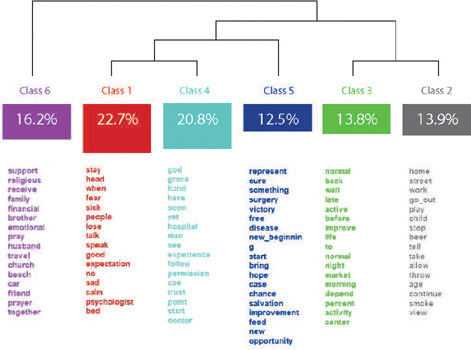-
ORIGINAL ARTICLE12-16-2023
Tangency and multiple factors of violence against lecturer: nuances of the experience in pedagogical practices in health education
Revista Brasileira de Enfermagem. 2023;76(1):e20210865
Abstract
ORIGINAL ARTICLETangency and multiple factors of violence against lecturer: nuances of the experience in pedagogical practices in health education
Revista Brasileira de Enfermagem. 2023;76(1):e20210865
DOI 10.1590/0034-7167-2021-0865
Views0See moreABSTRACT
Objective:
to identify factors that lead the teacher to experience violence in their pedagogical practice in health education.
Method:
research with a qualitative approach, based on the Grounded Theory, conducted with 11 professors of the nursing course of a public university in the central region of Brazil in 2020 and 2021. Online semi-structured interviews were analyzed partially in the light of the Constructivist Grounded Theory.
Results:
factors that lead lecturer to experience violence are characterized by institutional culture, gender, professor’s perception of violence, and the triggers that drive students to commit violence. Social status and inequalities lead to positions of domination and, consequently, create a fertile ground for violence.
Final Considerations:
analyzing violence under Bourdieu’s theory, it is clear that student violence towards lecturer and the reports contained in this study deserve pedagogical reflection. However, it is necessary to include these discussions as a background in teaching environments.

-
REVIEW12-16-2023
Multilevel model in the identification of behavioral and structural risk factors for HIV: integrative review
Revista Brasileira de Enfermagem. 2023;76(1):e20210853
Abstract
REVIEWMultilevel model in the identification of behavioral and structural risk factors for HIV: integrative review
Revista Brasileira de Enfermagem. 2023;76(1):e20210853
DOI 10.1590/0034-7167-2021-0853
Views0See moreABSTRACT
Objectives:
to investigate studies that adopted the multilevel analysis model to identify behavioral and structural risk factors associated with HIV infection.
Methods:
an integrative review of the literature with studies available in full, obtained from EMBASE, CINAHL, Pubmed, and Scopus, whose selected descriptors were the indexed terms: “HIV”, “multilevel analysis” and “behavior”.
Results:
the search resulted in 236 studies. Out of these, ten studies comprised the sample. Economic disadvantage, neighborhood characteristics, housing instability, incarceration, transactional sex, multiple partners, substance abuse, and age at first intercourse were classified as structural and behavioral risk factors for HIV. Reduced socioeconomic disadvantage, provision of housing stability, and condom use were associated with protective factors for HIV exposure.
Conclusions:
by applying the multilevel model in risk factor research studies, it was possible to identify the structural and behavioral elements of HIV risk.
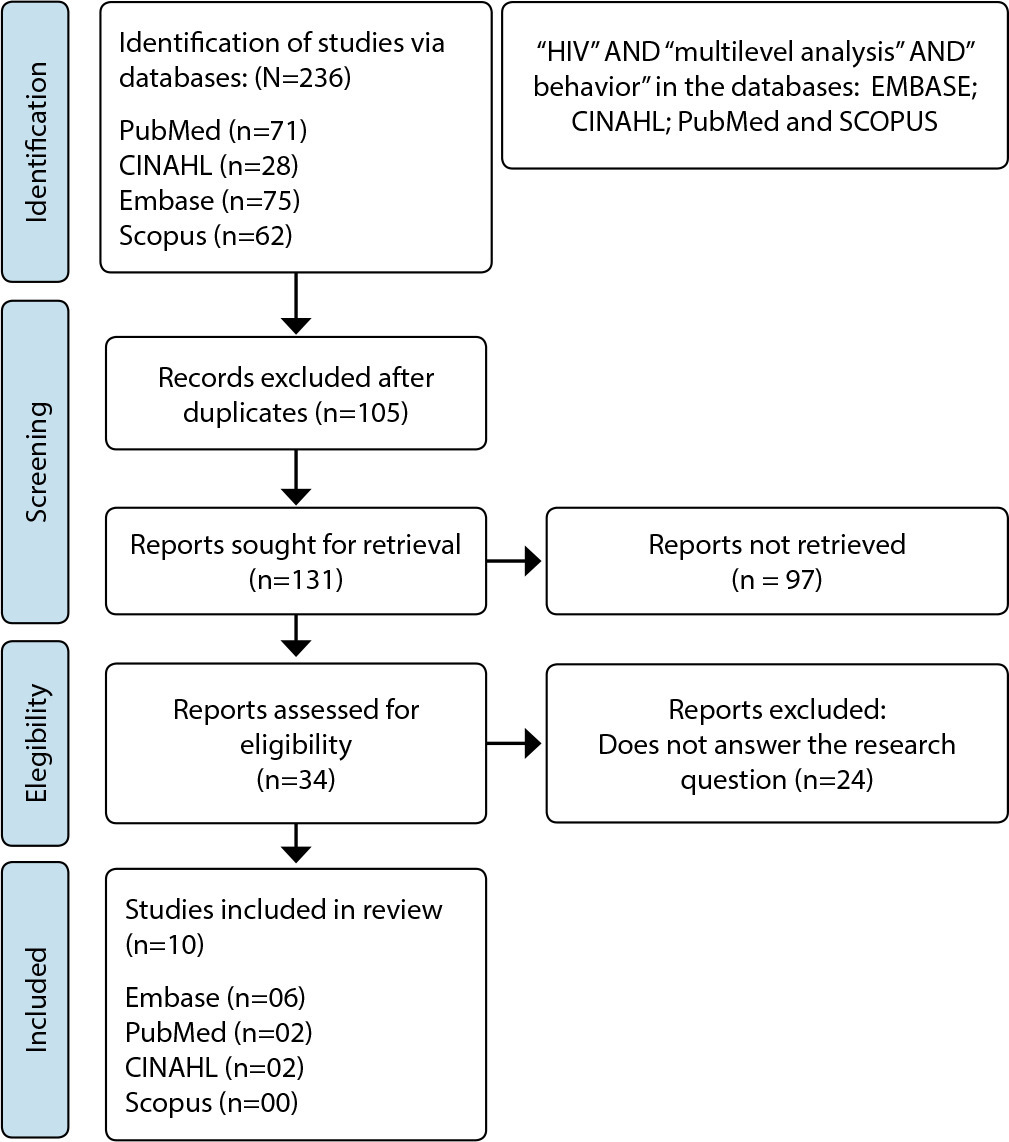
-
ORIGINAL ARTICLE12-16-2023
Fatores psicossociais correlacionados com a intenção comportamental das pessoas com diabetes mellitus tipo 2 (DM2) para uso de insulina
Revista Brasileira de Enfermagem. 2023;76(1):e20210617
Abstract
ORIGINAL ARTICLEFatores psicossociais correlacionados com a intenção comportamental das pessoas com diabetes mellitus tipo 2 (DM2) para uso de insulina
Revista Brasileira de Enfermagem. 2023;76(1):e20210617
DOI 10.1590/0034-7167-2021-0617
Views0See moreRESUMEN
Objetivos:
analizar los factores psicosociales correlacionados con la intención conductal de personas con diabetes mellitus tipo 2 (DM2) para uso de insulina.
Métodos:
estudio transversal. Instrumento validado basado en la Teoría de Conducta Planeada fue utilizada para identificar las medidas directas (actitud, norma subjetiva y control percibido), medidas indirectas (creencias conductuales, normativas y de control) e intención conductal para uso de insulina. Análisis descriptivo y correlación de Spearman fueron realizados para el análisis de datos.
Resultados:
un total de 211 individuos participaron del estudio, con una mediana positiva de intención conductal. Actitud, creencias normativas y conductuales fueron los predictores que presentaron una correlación significante (r=0,16, r=-0,15 y r=0,25, respectivamente; p<0,05) con la intención.
Conclusiones:
hay una intención conductal positiva en el uso de insulina por personas con DM2. Actitud, creencias Normativas y creencias conductuales tienen una correlación de baja magnitud con la intención de personas con DM2 de usar insulina.
-
ORIGINAL ARTICLE12-16-2023
Psychosocial factors related to the behavioral intention of people with type 2 diabetes using insulin
Revista Brasileira de Enfermagem. 2023;76(1):e20210617
Abstract
ORIGINAL ARTICLEPsychosocial factors related to the behavioral intention of people with type 2 diabetes using insulin
Revista Brasileira de Enfermagem. 2023;76(1):e20210617
DOI 10.1590/0034-7167-2021-0617
Views0See moreABSTRACT
Objectives:
to analyze the psychosocial factors correlated with the behavioral intention of people with Type 2 Diabetes Mellitus (T2DM) towards insulin use.
Methods:
a cross-sectional study; a validated instrument based on the Theory of Planned Behavior was used to identify the direct measures (attitude, subjective norm and perceived control), indirect measures (behavioral, normative and control beliefs) and behavioral intention for the use of insulin. Descriptive analysis and Spearman’s correlation were performed for data analysis.
Results:
a total of 211 individuals participated in the study, with a positive median of behavioral intention. Attitude, normative and behavioral beliefs were the psychosocial factors that presented a significant correlation (r=0.16, r=-0,15 and r=0.25, respectively; p<0.05) with the intention.
Conclusions:
there is a positive behavioral intention in the use of insulin by people with T2DM. Attitude, normative beliefs and behavioral beliefs have a low magnitude correlation with the intention of people with T2DM to use insulin.
-
ORIGINAL ARTICLE12-16-2023
Analysis of the convergence of the Safety Attitudes Questionnaire and the Hospital Survey on Patient Safety Culture
Revista Brasileira de Enfermagem. 2023;76(1):e20210379
Abstract
ORIGINAL ARTICLEAnalysis of the convergence of the Safety Attitudes Questionnaire and the Hospital Survey on Patient Safety Culture
Revista Brasileira de Enfermagem. 2023;76(1):e20210379
DOI 10.1590/0034-7167-2021-0379
Views0See moreABSTRACT
Objectives:
to analyze patient safety culture from nursing professionals’ perception at a university hospital, by assessing the convergence between the Safety Attitudes Questionnaire and the Hospital Survey on Patient Safety Culture.
Methods:
a cross-sectional study, with 434 nursing professionals. Data collection took place through the application of both instruments. Descriptive and inferential statistics were used.
Results:
in the Hospital Survey on Patient Safety Culture, the “teamwork within the units” dimension was considered a strong area of patient safety. In the Safety Attitudes Questionnaire, the “job satisfaction” and “perception of stress” domains reached the score for a good safety culture. Patient safety culture perception is correlated, in both instruments, with high magnitude.
Conclusions:
the two instruments converge towards a similar assessment of patient safety culture.
-
ERRATUM12-02-2022
ERRATUM
Revista Brasileira de Enfermagem. 2022;75(4):e2022n4e06
Abstract
ERRATUMERRATUM
Revista Brasileira de Enfermagem. 2022;75(4):e2022n4e06
DOI 10.1590/0034-7167.20227504e06
Views0In the article “Effects of multidisciplinary rounds and checklist in an Intensive Care Unit: a mixed methods study”, with DOI number: ”;, published in Revista Brasileira de Enfermagem, 2022;75(3):e20210934, in the abstract:Where it read:[…]See more -
ORIGINAL ARTICLE11-28-2023
Geospatialization of tuberculosis and income transfer programs among Indigenous peoples in an endemic territory
Revista Brasileira de Enfermagem. 2023;76:e20220216
Abstract
ORIGINAL ARTICLEGeospatialization of tuberculosis and income transfer programs among Indigenous peoples in an endemic territory
Revista Brasileira de Enfermagem. 2023;76:e20220216
DOI 10.1590/0034-7167-2022-0216
Views0ABSTRACT
Objective:
To analyze the spatial pattern of tuberculosis in Indigenous peoples from the State of Pará and its correlation with income transfer.
Methods:
Ecological study, with 340 cases reported in Indigenous peoples in the State of Pará, Brazil, in the period 2016-2020. The study performed a descriptive analysis and calculation of incidence rates with smoothing by the local empirical Bayesian method. The Global Moran index assessed the autocorrelation of the rates with income transfer data, p<0,05.
Results:
The Marajó and metropolitan mesoregions of Belém had the highest tuberculosis rates, and a reduced number of people benefited from income transfer (high-low correlation). The study identified high rates, and a significant number of people benefited from financial aid (high correlation high), I=0.399, p=0.027 in the Southwest.
Conclusions:
The spatial autocorrelation between tuberculosis and access to income transfer programs constitutes a relevant subsidy for the formulation of social protection policies and may impact the disease control actions in Indigenous territories, valuing the epidemiological heterogeneity identified in the mesoregions.
Keywords:Geographic Information SystemsGovernment ProgramsHealth of Indigenous PeoplesSpatial AnalysisTuberculosisSee more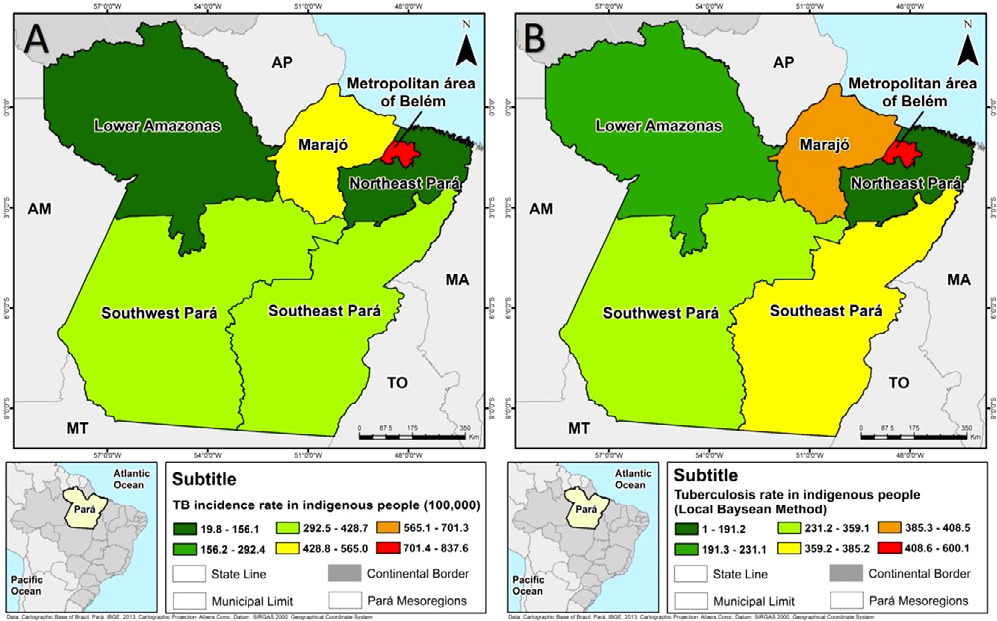
-
ORIGINAL ARTICLE11-28-2023
Remote consultation with people with eating disorders during the COVID-19 pandemic
Revista Brasileira de Enfermagem. 2023;76:e20220197
Abstract
ORIGINAL ARTICLERemote consultation with people with eating disorders during the COVID-19 pandemic
Revista Brasileira de Enfermagem. 2023;76:e20220197
DOI 10.1590/0034-7167-2022-0197
Views0See moreABSTRACT
Objectives:
to analyze subjective experiences related to adaptation to remote care by users with eating disorders during the COVID-19 pandemic.
Methods:
a descriptive study with a qualitative approach conducted with users of an eating disorders outpatient clinic. A semi-structured remote interview was applied using the Google Meet application. The data were submitted to lexical analysis using ALCESTE software and discussed in the light of scientific evidence.
Results:
the remote appointment is a positive strategy but not a substitute for the face-to-face modality. The research cited financial savings, closer contact with professionals, and flexibility of service schedules as advantages. It pointed out the difficulty in clinical evaluation concerning weight, vital signs, and poor mastery of technology as limitations.
Final Considerations:
the study induces discussion about the systematization of remote care, which, during the COVID-19 pandemic, were responsible for providing a greater sense of support to people with eating disorders.
-
ERRATUM01-01-2016
ERRATUM
Revista Brasileira de Enfermagem. 2016;69(1):206-206
Abstract
ERRATUMERRATUM
Revista Brasileira de Enfermagem. 2016;69(1):206-206
DOI 10.1590/0034-7167.20166901e02
Views0In the article “Conceptions of mid-level nursing professionals facing those with a chemical dependency”, with the number of DOI: 10.1590/0034-7167.2015680610i, published in the journal Revista Brasileira de Enfermagem, v68(6):755-60, page 760 that read:“8. Vargas D, Soares J. Knowledge and attitudes of nurses towards alcohol and related problems: the impact of an educational intervention. Rev Esc […]See more -
ERRATUM01-01-2016
ERRATUM
Revista Brasileira de Enfermagem. 2016;69(1):205-205
Abstract
ERRATUMERRATUM
Revista Brasileira de Enfermagem. 2016;69(1):205-205
DOI 10.1590/0034-7167.20166901e01
Views0In the article “Using the theory of meaningful learning in nursing education”, with the number of DOI: 10.1590/0034-7167.2015680420i, published in the journal Revista Brasileira de Enfermagem, v68(4):626-35, page 627 that read:“Ausubel was descended from Jewish, born in New York in 1918 and died in 1994 at the age of 75. He thought and wrote until […]See more -
EXPERIENCE REPORT01-01-2016
Nursing process documentation: rationale and methods of analytical study
Revista Brasileira de Enfermagem. 2016;69(1):197-204
Abstract
EXPERIENCE REPORTNursing process documentation: rationale and methods of analytical study
Revista Brasileira de Enfermagem. 2016;69(1):197-204
DOI 10.1590/0034-7167.2016690126i
Views0See moreABSTRACT
Objective:
to describe the methods used to analyze the associations between variables of service, nursing and the nursing process documentation in institutions of the Department of Health of the State of São Paulo.
Method:
multilevel analytical study with data obtained in the domains of institution, units of the institution and nursing professionals who work there, using standardized instruments. The analyses had as axis the degree of completeness of the nursing process documentation in units or institutions and their association with variables of nursing personnel, of units and of institutions.
Conclusion:
This study will provide important empirical evidence on the factors involved in the nursing process documentation.
-
EXPERIENCE REPORT01-01-2016
Qualitative methodologies in health research: interpretive referential of Patricia Benner
Revista Brasileira de Enfermagem. 2016;69(1):192-196
Abstract
EXPERIENCE REPORTQualitative methodologies in health research: interpretive referential of Patricia Benner
Revista Brasileira de Enfermagem. 2016;69(1):192-196
DOI 10.1590/0034-7167.2016690125i
Views0See moreABSTRACT
Objective:
this article reports on the experience of using the interpretive phenomenological framework of Patricia Benner in a Brazilian context. Benner’s interpretive phenomenology, based on existential and interpretative philosophy, aims to understand human experiences in the particular worlds of research participants. Data were collected through interviews with nine nurses in November and December 2014.
Results:
data analysis process according to Benner’s framework consisted of: transcription, coding, thematic analysis, and search for paradigmatic cases and examples. Therefore, the prior knowledge of the researcher is an important part of the study, consisting in manners of the research conduction.
Conclusion:
The use of this methodological framework entailed a great challenge for the researcher, however, it also enabled a unique opportunity to illuminate important existential phenomena related to the daily lives of research participants.
-
REVIEW01-01-2016
Nurses’ performance on primary care in the National Health Service in England
Revista Brasileira de Enfermagem. 2016;69(1):182-191
Abstract
REVIEWNurses’ performance on primary care in the National Health Service in England
Revista Brasileira de Enfermagem. 2016;69(1):182-191
DOI 10.1590/0034-7167.2016690124i
Views0See moreABSTRACT
Objective:
To analyze the expansion of nursing roles in primary care in the English National Health Service and the implications for professional practice.
Method:
qualitative research in case study format, held in London, England, in six primary care units. Data were obtained through interviews with nine nurses. After the thematic data analysis, two units emerged: the nurses’ performance characteristics and effects of the expansion of nursing roles.
Results:
expansion of nurses’ roles: consultation, diagnosis and drug therapy, case management and monitoring of chronic conditions. Repercussions: for the user, there was improved access, communication and comprehensive care, increased duration of consultations, resulting in greater adherence; for nurses, there was the expansion of professional skills, knowledge and professional recognition; to the health care system, it resulted in cost savings.
Conclusion:
benefits in expanding nursing roles, were visible, contributing to primary care quality.
-
REVIEW01-01-2016
Meleis’ Nursing Theories Evaluation: integrative review
Revista Brasileira de Enfermagem. 2016;69(1):174-181
Abstract
REVIEWMeleis’ Nursing Theories Evaluation: integrative review
Revista Brasileira de Enfermagem. 2016;69(1):174-181
DOI 10.1590/0034-7167.2016690123i
Views0See moreABSTRACT
Objective:
to analyze the application of the theory evaluation model proposed by Meleis in Brazilian studies.
Method:
integrative review of online articles published from 2002 to 2012 in the databases LILACS and BDENF.
Results:
the 16 selected studies confirmed the use of only three of the five stages proposed for Meleis’ theories analysis: Description of the Theory, Criticism of the Theory and Analysis of the Theory, with a predominance of a single unit of analysis in each.
Conclusion:
the analysis of nursing theories provides support to nurses in the practice, research, education and administration of the different dimensions of care. Meleis’ model figures as very important by contributing to the development of knowledge of nursing discipline, considering that its use as a method allows several reflections on theories in order that they be revalidated to support a more theoretical and practical applicability.
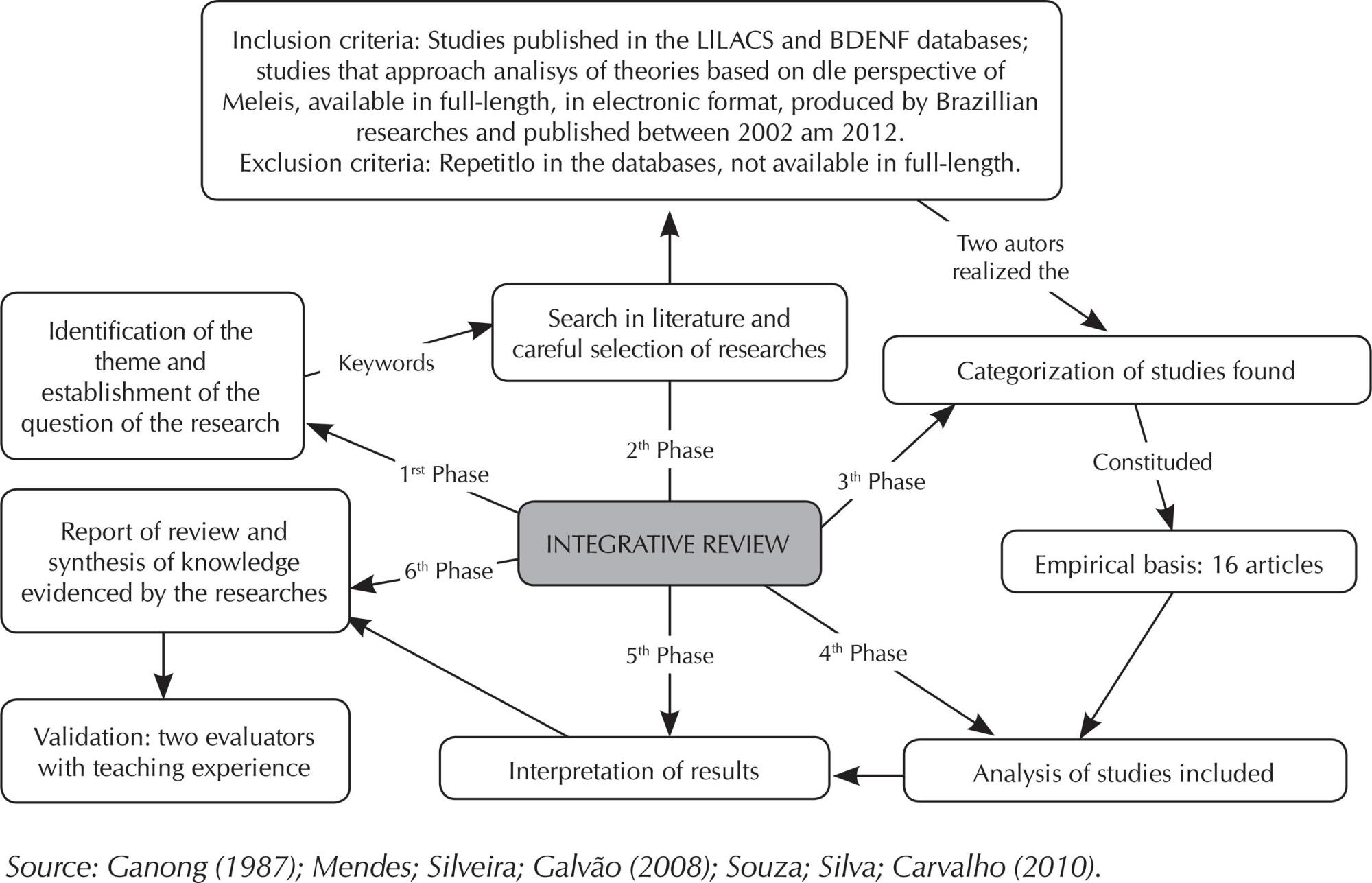
-
REVIEW01-01-2016
Clinical indicators of sexual dysfunction in pregnant women: integrative literature review
Revista Brasileira de Enfermagem. 2016;69(1):165-173
Abstract
REVIEWClinical indicators of sexual dysfunction in pregnant women: integrative literature review
Revista Brasileira de Enfermagem. 2016;69(1):165-173
DOI 10.1590/0034-7167.2016690122i
Views0ABSTRACT
Objective:
to identify the nursing diagnosis clinical indicators of sexual dysfunction in pregnant women.
Method:
it is an integrative literature review, with research in databases using the keywords “sexual*”, “pregnan*” and “function*”. Studies included had an abstract available for analysis, referring to pregnant women over 18 years old, written in Portuguese, French, Spanish and English, with publication date between 2010 and 2014. Studies that reporting pregnant women with an associated pathology were excluded.
Results:
sexual dysfunction in pregnant women is consistent in the literature. Nine defining characteristics were identified and 16 related factors, some not classified in NANDA International.
Conclusion:
clinical indicators can be added to the nursing diagnosis to favor an accurate diagnosis and effective interventions in the surveillance of pregnancy as a period of healthy sexual experience.
Keywords:Physiological Sexual Dysfunction, Psychogenic Sexual DysfunctionPregnant WomenReviewSexual BehaviorSee more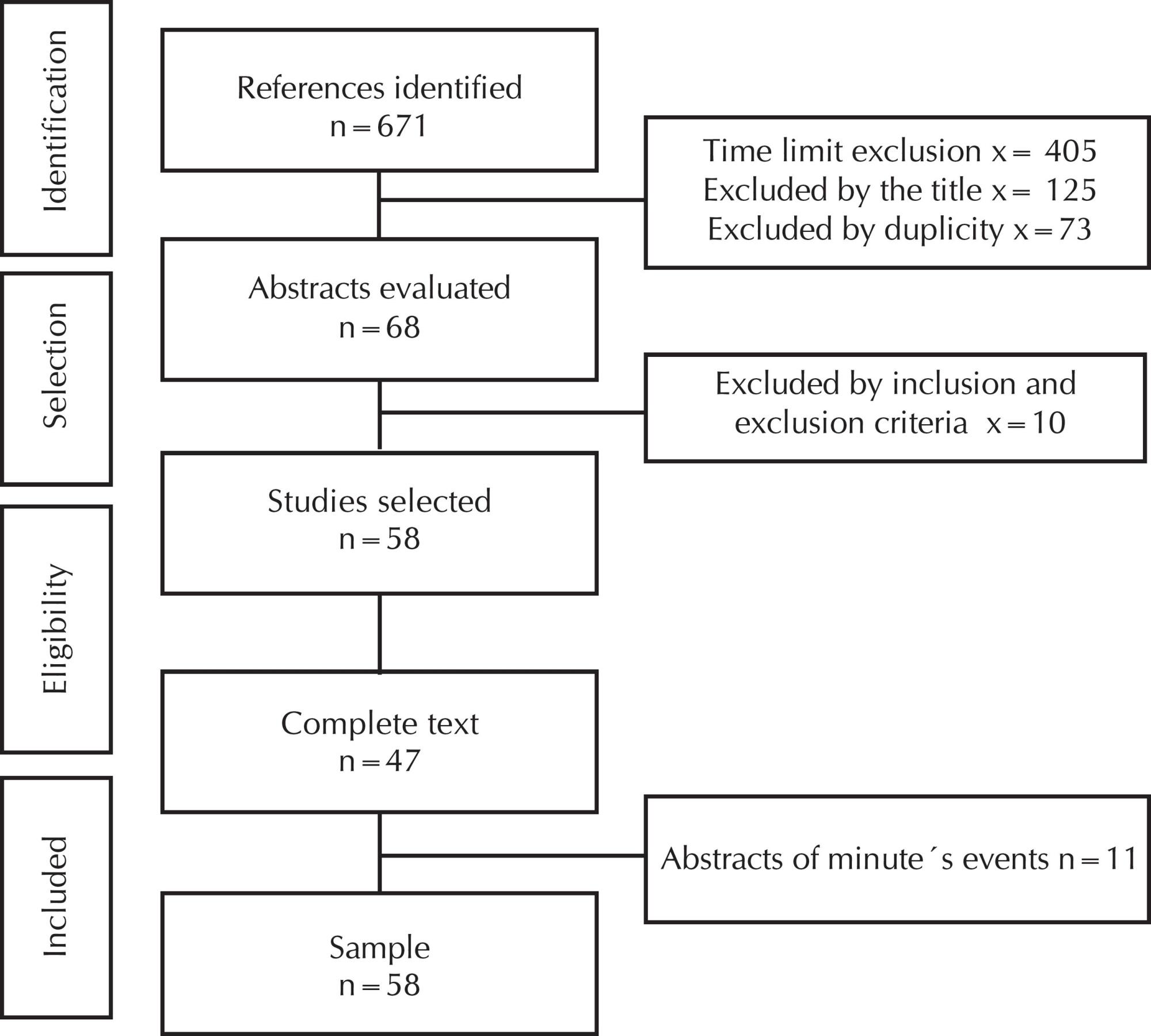
-
RESEARCH01-01-2016
Conditions of functional health literacy of an elderly diabetics group
Revista Brasileira de Enfermagem. 2016;69(1):156-164
Abstract
RESEARCHConditions of functional health literacy of an elderly diabetics group
Revista Brasileira de Enfermagem. 2016;69(1):156-164
DOI 10.1590/0034-7167.2016690121i
Views0See moreABSTRACT
Objective:
to evaluate the conditions of functional health literacy of an elderly diabetics group.
Method:
cross-sectional and descriptive study, with diabetic’s elderly assisted in the SUS (N = 114). The social and health conditions were evaluated as well as functional health literacy by S-TOFHLA test (short version); the simple proportions, average, standard deviation and Pearson’s Chi-square were described by SPSS software (20.0) with α = 5% value.
Results:
the mean age was 67.4 years, 74.0% of the elderly were women, had up to four years of schooling; 29.8% had a long-standing illness, 64.0% reported having high blood pressure, 47.4% smoke or were smokers, 73.7% had low functional health literacy, which was associated with schooling p = 0.001.
Conclusions:
the low functional health literacy could be a self-care conditioning and can be influenced by low schooling because it implies to have skills to understand and make decisions aimed at self-management of health.
-
ERRATUM01-13-2024
ERRATUM
Revista Brasileira de Enfermagem. 2024;77(6):e2024n6e08
Abstract
ERRATUMERRATUM
Revista Brasileira de Enfermagem. 2024;77(6):e2024n6e08
DOI 10.1590/0034-7167.20247706e08
Views0In the article “Brazilian nursing specific situation, middle and micro-range theories: a bibliometric study”, with DOI number: , published in Revista Brasileira de Enfermagem, 2024;77(4):e20230520, Chart 1:Where it read:[…]See more -
ERRATUM01-13-2024
ERRATA
Revista Brasileira de Enfermagem. 2024;77(6):e2024n6e07
Abstract
ERRATUMERRATA
Revista Brasileira de Enfermagem. 2024;77(6):e2024n6e07
DOI 10.1590/0034-7167.20247706e06pt
Views0No artigo “Crenças e atitudes de pais ou responsáveis legais sobre a vacinação infantil: revisão de escopo”, com número DOI: , publicado no periódico Revista Brasileira de Enfermagem, 2024;77(4):e20240126, página 5:Onde se lia:[…]See more -
ORIGINAL ARTICLE01-13-2024
Indicators associated with severity and mortality in hospitalized people with HIV: A retrospective cohort
Revista Brasileira de Enfermagem. 2024;77(6):e20240204
Abstract
ORIGINAL ARTICLEIndicators associated with severity and mortality in hospitalized people with HIV: A retrospective cohort
Revista Brasileira de Enfermagem. 2024;77(6):e20240204
DOI 10.1590/0034-7167-2024-0204
Views0See moreABSTRACT
Objectives:
to compare the sociodemographic and clinical severity indicators of hospitalized people with HIV in relation to clinical outcomes and urgent hospital admission.
Methods:
a retrospective cohort study was conducted with 102 medical records of HIV-infected individuals hospitalized in a hospital in southern Brazil. In addition to descriptive analysis, Fisher’s exact test, Pearson’s Chi-square, and logistic regression were used.
Results:
the data showed a significant direct effect on severity indicators in the following variables: male sex (p=0.013), skin color (p=0.023), level of education (p=0.000), urgent admissions (p=0.000), late diagnosis (p=0.001), diabetes mellitus (p=0.001), hypertension (p=0.004), kidney disease (p=0.002), high viral load (p=0.006), CD4+ count below 200 (p=0.005), fever (p=0.016), weight loss (p=0.013), co-infection with hepatitis C (p=0.004), and mortality (p=0.007).
Conclusions:
three sociodemographic and thirteen clinical markers were identified as being associated with the risk of clinical deterioration in hospitalized people with HIV.
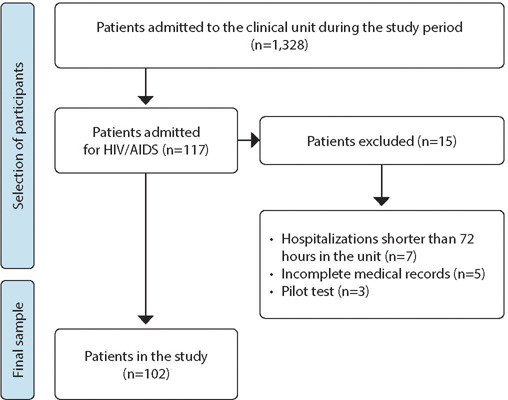
-
ORIGINAL ARTICLE01-13-2024
Nurses’ perspectives on the use of telemonitoring in the management of people with diabetes and hypertension
Revista Brasileira de Enfermagem. 2024;77(6):e20230481
Abstract
ORIGINAL ARTICLENurses’ perspectives on the use of telemonitoring in the management of people with diabetes and hypertension
Revista Brasileira de Enfermagem. 2024;77(6):e20230481
DOI 10.1590/0034-7167-2023-0481
Views1See moreABSTRACT
Objectives:
to understand the perspective of nurses on the use of telemonitoring in the management of people with type 2 diabetes mellitus and arterial hypertension in primary care.
Methods:
this qualitative research involved sixteen nurses from eight municipalities in Paraná. Data were collected between November 2022 and January 2023 through inperson or remote interviews, which were audio-recorded and subjected to content analysis.
Results:
according to the nurses, telemonitoring enhances users’ knowledge about these conditions, communication and connection with the team, and productivity. However, the lack of electronic resources and equipment, high staff turnover, low user adherence, and the limited availability of professional time present significant challenges.
Final Considerations:
the effective implementation and operation of telemonitoring in the management of people with diabetes and hypertension involve both potential benefits and barriers. It is essential to have the availability of human and technological resources, managerial support, and the commitment of professionals and users.
-
ORIGINAL ARTICLE01-13-2024
Knowledge, Attitudes, and Practices of nurses regarding blood culture collection
Revista Brasileira de Enfermagem. 2024;77(6):e20230424
Abstract
ORIGINAL ARTICLEKnowledge, Attitudes, and Practices of nurses regarding blood culture collection
Revista Brasileira de Enfermagem. 2024;77(6):e20230424
DOI 10.1590/0034-7167-2023-0424
Views0ABSTRACT
Objectives:
to investigate the knowledge, attitudes, and practices of nurses regarding blood culture collection.
Methods:
a cross-sectional study was conducted in five Brazilian public hospitals with 112 nurses. Data were collected using an adapted questionnaire and analyzed through descriptive and inferential statistics.
Results:
nurses who did not consider themselves capable of collecting blood cultures had a 72% lower chance of performing the collection at the recommended site and an 83% lower chance of using the same needle for blood inoculation into the vials. Nurses working in the emergency department had a 75% lower chance of knowing the international benchmark for blood culture contamination rates, and those with less than 5 years in the position decreased their chance of accuracy in this matter by 79%.
Conclusions:
there are gaps in the knowledge, attitudes, and practices of nurses regarding blood culture collection. Standardization of the technique, periodic education, supervision and guidance of the collection team, and process auditing are recommended coping strategies.
Keywords:Blood CultureBlood Specimen CollectionHealth Knowledge, Attitudes, PracticeNursing CareQuality of Health CareSee more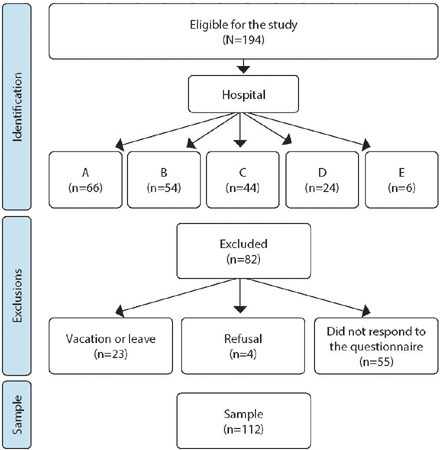
-
ORIGINAL ARTICLE01-13-2024
Evaluation of care for people with HIV in Primary Health Care: construct validation
Revista Brasileira de Enfermagem. 2024;77(6):e20230190
Abstract
ORIGINAL ARTICLEEvaluation of care for people with HIV in Primary Health Care: construct validation
Revista Brasileira de Enfermagem. 2024;77(6):e20230190
DOI 10.1590/0034-7167-2023-0190
Views0ABSTRACT
Objectives:
to verify the construct validation of an instrument for evaluating care for people living with HIV in Primary Health Care.
Methods:
methodological study carried out in 2021 with 260 health professionals in Recife, PE. Validation based on the internal structure was carried out at this stage using exploratory and confirmatory factor analysis, and validity based on item response theory.
Results:
the validation determined the retention of five factors and 63 items. The instrument’s internal consistency and quality of fit was 0.90, the Tukey-Lewis index was 0.915 and the comparative fit index was 0.918 in the confirmatory factor analysis. The indication for the absolute majority of items is adequate fit.
Conclusions:
the instrument has construct validity, making it possible to use it to evaluate the decentralization process and care for People Living with HIV in Primary Health Care.
Keywords:Acquired Immunodeficiency SyndromeComprehensive Health CareHIVPrimary Health CareProgram EvaluationSee more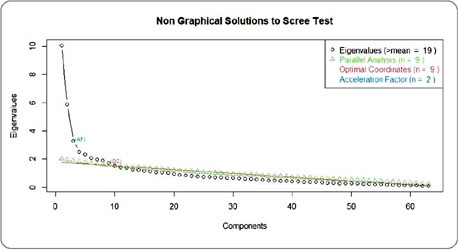
-
ORIGINAL ARTICLE01-10-2024
Inventory of ethical problems in mobile pre-hospital care
Revista Brasileira de Enfermagem. 2024;77:e20230539
Abstract
ORIGINAL ARTICLEInventory of ethical problems in mobile pre-hospital care
Revista Brasileira de Enfermagem. 2024;77:e20230539
DOI 10.1590/0034-7167-2023-0539
Views0See moreABSTRACT
Objective:
to construct and validate the content of an inventory of ethical problems experienced by nurses in mobile pre-hospital care.
Method:
a psychometric approach study, developed with the following stages: (1) instrument construction through a theoretical matrix based on deliberative bioethics, scoping review and online qualitative research; (2) content validity by judges; (3) pre-testing with Mobile Emergency Care Service nurses in various Brazilian states. For content validity analysis, the Content Validity Ratio was calculated (CVR>0.45 for judges and CVR>0.35 for the target population).
Results:
the instrument had 44 items, distributed across four dimensions.
Final considerations:
the constructed instrument presented sources of evidence of content validity, providing good psychometric measurements and constituting a useful tool for nurses’ practice in the pre-hospital setting.
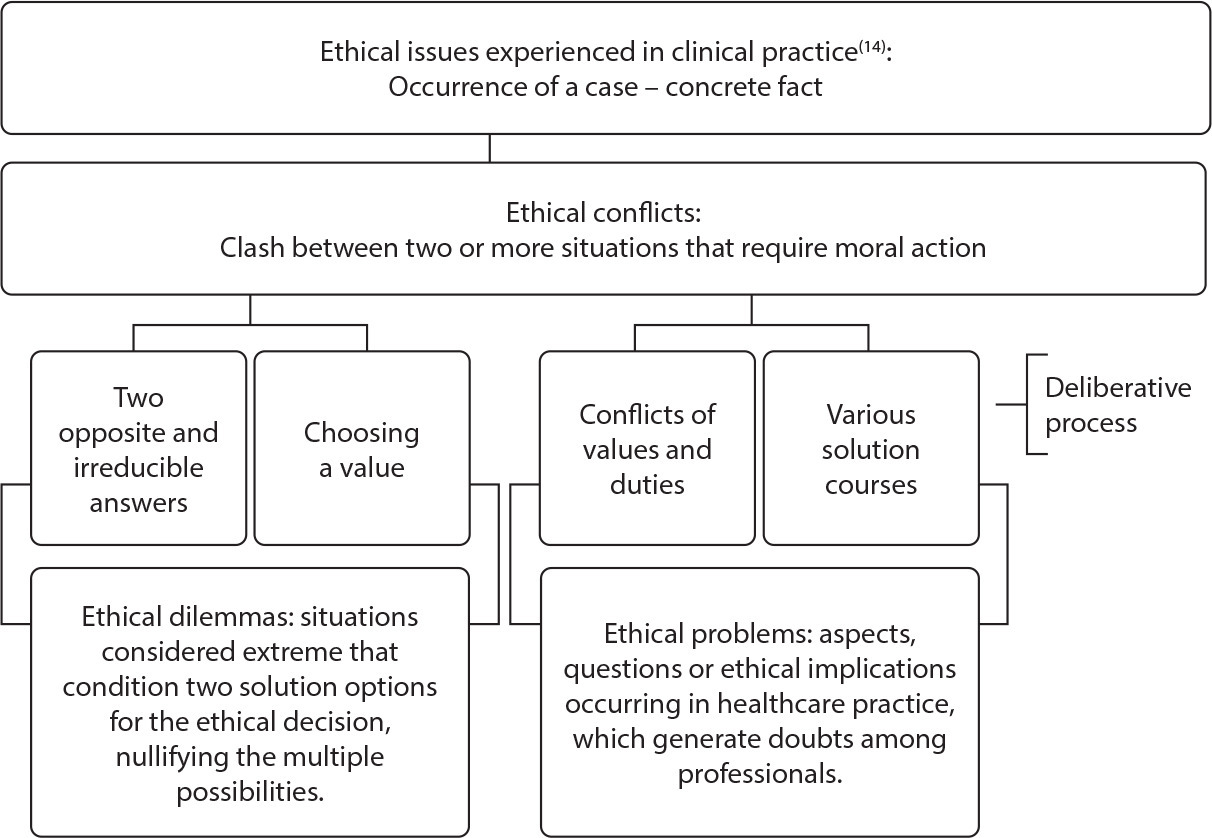
Search
Search in:
Nuvem de Tags
Aged (144) Atenção Primária à Saúde (239) COVID-19 (104) Cuidados de Enfermagem (269) Educação em Enfermagem (151) Educação em Saúde (139) Enfermagem (930) Estudos de Validação (131) Health Education (144) Idoso (208) Mental Health (149) Nursing (987) Nursing Care (306) Patient Safety (151) Primary Health Care (284) Qualidade de Vida (104) Quality of Life (106) Saúde Mental (145) Segurança do Paciente (150) Validation Studies (108)




